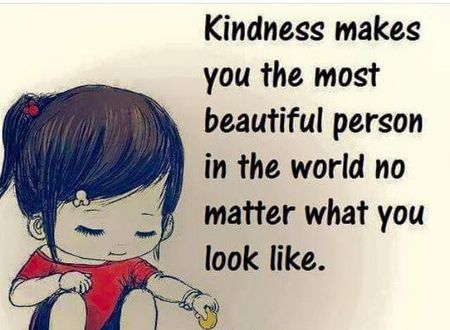
One of my favorite quotes is “What knowledge is there that is greater than kindness.” When I first heard this thought, it literally rocked my universe. I was brought up to believe that knowledge was the greatest treasure of all. Knowledge was power. Knowledge could make you a King or Queen or President. Knowledge was everything. Knowledge fed IQ and people with higher IQ’s were more successful than people with lower IQ’s. Books were the source of knowledge. Books were like Campbell Soup. Knowledge condensed into a compact form. All I had to do was open a book, read, and get knowledge that would make me smart and powerful.

I completed my Ph.D. I was the first one in my family to go to college let alone get a Ph.D. After finishing my Ph.D. dissertation, I took the Mensa test and joined the organization. I thought I had just about reached as high as possible in self-development. I had two certificates to show how smart I was. Then I heard about Emotional Intelligence (called EQ by Daniel Goldstein who pioneered the concept). EQ surprised me because truth be told, I thought there was something still missing in in my life. I had an IQ of 137 but my EQ was more like zero. I did not have much compassion or sympathy for lazy people, stupid people, dishonest people and loads of people who did not live up to my expectations. I decided that I needed to work on my EQ and downplay the role of IQ in my life.
I realized that as another famous quote goes “Knowledge helps you to make a living, but wisdom helps you to make a life.” Wisdom is a combination of EQ and IQ and of course experience in living. This is why Native Americans value the elders in their societies. The elderly should have (but sadly often do not today) the experience and wisdom that can help guide the young. I wanted to seek out more things that would help me to learn compassion and wisdom. Over the years, my forty retreats, various support groups and readings have helped me to gain a better understanding of the need for EQ. I thought I was doing well until just recently.

Karen and I have had our quarrels and disagreements over the years. They have become less frequent after three weekends at Marriage Encounters, numerous trips to a marriage counselor, and more “family meetings” than I can count. We have now been married over 34 years and most of it very happy despite some rough spots. I will honestly and humbly admit though that without some counseling and the three marriage encounter weekends we attended that we might not still be together.
 Nevertheless, we still have the occasional spat, and they usually leave us both feeling quite depressed and disappointed. I am mostly disappointed with myself for not handing things well. It seems I too often say things or discuss things very differently than we have agreed on. We have found and used many models for dealing with conflict. One of our favorites is the “DESC” model. This stands for “Describe” what is happening in neutral terms. Talk about how this makes you feel in terms of “Emotions.” “Specify” what you would like to see happen differently. Define what the “Consequences” will or could be for change. Consequences are best provided that are positive, such as we will feel closer together. When we stick to this model things seem to go well. Our discussions stay on track and our resolutions come more effortlessly. When we stray from the model, accusations and insinuations escalate and the discussion becomes difficult if not painful.
Nevertheless, we still have the occasional spat, and they usually leave us both feeling quite depressed and disappointed. I am mostly disappointed with myself for not handing things well. It seems I too often say things or discuss things very differently than we have agreed on. We have found and used many models for dealing with conflict. One of our favorites is the “DESC” model. This stands for “Describe” what is happening in neutral terms. Talk about how this makes you feel in terms of “Emotions.” “Specify” what you would like to see happen differently. Define what the “Consequences” will or could be for change. Consequences are best provided that are positive, such as we will feel closer together. When we stick to this model things seem to go well. Our discussions stay on track and our resolutions come more effortlessly. When we stray from the model, accusations and insinuations escalate and the discussion becomes difficult if not painful.
After one of our arguments the other day, I had a sudden insight that was the inspiration for this blog. I have noticed that I try to do a lot of things for Karen. I help her take her instruments to her music sessions. I do a lot of the shopping. I do dishes and laundry. I help her in and out of the car. I sometimes wonder how she could not feel totally loved. She in turn does a lot of things for me but somehow, I often feel unloved. Out of the blue, I realized that we both try to show our love by doing “things” for each other. However, when it comes to emotional displays that show love, it seems harder for each of us.
My insight was that there are two kinds of kindness. One I will call “Physical Kindness.” Doing things that are physical and overt for another. Taking the garbage out. Cooking or baking the things that your partner loves. Running errands for each other. Giving nice gifts. These are all examples of what I would call “Physical Kindness.” I think I am very good at these things as is my spouse.
 The other kind of kindness I will call “Emotional Kindness.” This is not doing things but saying things either verbal or non-verbal that honor and appreciate the other person. It respects their feelings more than their actions. It might be “I love you” or it might be an appreciation of something the other person says or thinks. It is building up the other person’s self-esteem and not putting down anything they might express or care about.
The other kind of kindness I will call “Emotional Kindness.” This is not doing things but saying things either verbal or non-verbal that honor and appreciate the other person. It respects their feelings more than their actions. It might be “I love you” or it might be an appreciation of something the other person says or thinks. It is building up the other person’s self-esteem and not putting down anything they might express or care about.
Upon more reflection, I could see that there are many times when I am not “Emotionally Kind.” I ignore or miss opportunities for empathy and emotional support. Telling someone that “When the going gets tough the tough get going” or “There is no try, there is only do or do not” are examples of my previous “emotional support.” I should not have been surprised that Karen was never smitten by these suggestions. Perhaps I should retire these two maxims from my lexicon. I know I need to learn more varieties of Emotional Kindness.

The lesson I have learned, and I hope that this blog somewhat illustrates is that kindness can take many forms. I have talked about two that are salient to me now. There is a good book worth reading called the “Five Love Languages.” It is written by Gary Chapman. This book teaches that there are several ways to transmit your feelings of love to others. Just as different people have different preferences for how they learn, the same is true for love and kindness. You must learn what the recipient of your intended love or kindness resonates with. It is like finding the right channel on a radio. You must dial it in correctly or you can not connect.

Jul 24, 2023 @ 10:23:41
This is a terrific post, John. Your growth in self-awareness deserves applause – and support for continuing the journey. Dispensing with those 2 quotes about the going getting tough seems like a very, very good plan!!! 😏😊
LikeLike
Jul 24, 2023 @ 12:51:27
Thanks Jane, I thought you might approve. John
LikeLiked by 1 person
Jul 24, 2023 @ 18:36:26
“You must learn what the recipient of your intended love or kindness resonates with.”…. WOW! I love this line….Kindness can be expressed in many forms… words, actions, emotions; tangible or intangible… whatever the deed, Kindness matters..
LikeLike
Jul 25, 2023 @ 10:40:27
Thanks Lin. Once in a while I guess I sound somewhat poetic. Not my long suit though.
LikeLike
Jul 24, 2023 @ 19:59:27
Thanks John for sharing a very personal post with which I can readily empathize! I have always tended to be the physical kindness type and continually going out of my way to help people but not always so emotionally open.
I need to think on this one for a bit and hopefully absorb some of your wisdom.
LikeLike
Jul 25, 2023 @ 10:39:29
Thanks Wayne. I will need to do a better job here as well. Hope you are staying chilled. John
LikeLike